Are you tired of the mundane 9-to-5 grind? Do you find yourself craving excitement and adventure in your professional life? If you’re an adrenaline junkie seeking a career that will keep your heart racing, you’ve come to the right place! In this comprehensive guide, we’ll explore the top 20 jobs that are perfect for thrill-seekers like you. From the death-defying stunts of Hollywood to the heart-pounding rescues in the great outdoors, these careers offer the ultimate rush for those who live life on the edge. Get ready to buckle up and discover a world of exhilarating possibilities!
What You’ll Learn
- Discover the most thrilling careers for adrenaline seekers
- Explore the key responsibilities and skills required for each job
- Learn about the average salaries and potential career paths
- Gain insights into the fast-paced and exciting work environments
- Find the perfect match for your thrill-seeking personality
By the end of this article, you’ll have a thorough understanding of the best jobs available for adrenaline enthusiasts. Whether you’re a daredevil looking to make a career change or a young adventurer just starting out, this guide will provide you with the knowledge and inspiration to pursue your dreams. So, let’s dive in and explore the adrenaline-pumping world of extreme careers!
20. Explosive Ordnance Disposal (EOD) Technician

Average Salary: $50,000 – $90,000 per year
Explosive Ordnance Disposal (EOD) Technicians are the brave and highly skilled individuals who risk their lives to identify, disarm, and dispose of explosive devices and ordnance.
This challenging and high-stakes career is ideal for adrenaline seekers who have a strong sense of duty, a cool head under pressure, and a desire to save lives and protect communities from the threat of explosives.
Job Duties:
- Identifying Explosive Devices: Investigate and identify suspected explosive devices, using specialized equipment and techniques to determine the type and characteristics of the device.
- Rendering Devices Safe: Employ a variety of methods, such as remote disruption, manual disarmament, or controlled detonation, to neutralize and safely dispose of explosive devices.
- Conducting Post-Blast Investigations: Analyze post-blast scenes to collect evidence, identify the type of explosive used, and assist in determining the cause and origin of the blast.
- Providing Technical Support: Offer technical expertise and support to law enforcement, military, and other agencies in matters related to explosives and ordnance.
- Maintaining Proficiency: Engage in continuous training and education to stay current with the latest techniques, technologies, and best practices in the field of EOD.
- Ensuring Safety: Adhere to strict safety protocols, manage the risks associated with handling explosives, and work to protect the lives of team members and the public.
Requirements:
- EOD Certification: Completion of a rigorous EOD training program, such as the Naval School Explosive Ordnance Disposal (NAVSCOLEOD) or the FBI’s Hazardous Devices School.
- Military or Law Enforcement Background: Prior experience in the military or law enforcement, often with specialized training in explosives, weapons, or tactical operations.
- Technical Aptitude: Strong technical skills and the ability to quickly learn and adapt to new tools, technologies, and procedures.
- Problem-Solving Skills: Exceptional problem-solving abilities and the capacity to think critically and make sound decisions in high-pressure situations.
- Physical Fitness: Excellent physical condition and the ability to work in challenging environments while wearing protective gear.
- Mental Resilience: Strong mental and emotional resilience to cope with the inherent dangers and stresses of working with explosives.
Career Path and Growth:
EOD Technicians typically begin their careers by enlisting in the military or joining a law enforcement agency, followed by specialized training in explosive ordnance disposal.
With experience and demonstrated proficiency, technicians may advance to leadership positions, such as team leader or senior EOD technician, taking on greater responsibilities and mentoring junior team members.
After completing their military or law enforcement service, many EOD Technicians transition to careers in the private sector, such as security consulting, counterterrorism, or specialized training roles, leveraging their unique skills and experience to continue protecting communities from explosive threats.
19. Professional Athlete

Average Salary: $50,000 – $1,000,000+ per year
Professional Athletes are the elite competitors who push the boundaries of human performance, competing at the highest levels of their chosen sports.
This high-stakes and physically demanding career is perfect for adrenaline seekers who have the talent, dedication, and competitive drive to excel in the world of professional sports.
Job Duties:
- Training and Conditioning: Engage in rigorous training and conditioning programs to maintain peak physical performance and refine sport-specific skills.
- Competing in Events: Participate in professional-level competitions, tournaments, and games, striving to achieve victory and set new records.
- Studying Game Footage: Analyze own performance and that of opponents to identify strengths, weaknesses, and areas for improvement.
- Collaborating with Coaches: Work closely with coaches and trainers to develop strategies, refine techniques, and optimize performance.
- Media and Sponsorship Obligations: Engage with media, fans, and sponsors through interviews, appearances, and endorsement activities.
- Maintaining Professionalism: Adhere to the rules and regulations of the sport, demonstrate sportsmanship, and serve as a positive role model for aspiring athletes.
Requirements:
- Exceptional Athletic Ability: Extraordinary talent and skill in the chosen sport, often evident from a young age and honed through years of practice and competition.
- Dedication and Work Ethic: Unwavering commitment to training, practice, and continuous improvement, often requiring significant personal sacrifices.
- Competitive Drive: Fierce competitive spirit and the mental toughness to perform under pressure and bounce back from setbacks.
- Physical Fitness: Outstanding physical condition, strength, speed, agility, and endurance, tailored to the specific demands of the sport.
- Coachability: Willingness to accept constructive feedback, adapt to new techniques and strategies, and continuously strive for self-improvement.
- Resilience: Ability to overcome injuries, setbacks, and disappointments, maintaining focus and determination in the face of adversity.
Career Path and Growth:
The path to becoming a Professional Athlete often begins at a young age, with a strong showing in youth and amateur competitions, followed by recruitment to college or professional teams.
As athletes progress and achieve success, they may attract lucrative contracts, endorsement deals, and opportunities to compete at the highest levels of their sport.
After retiring from active competition, many Professional Athletes transition to roles such as coaching, broadcasting, or sports management, leveraging their experience and knowledge to contribute to the sport in new ways.
18. Parkour Instructor

Average Salary: $30,000 – $50,000 per year
Parkour Instructors are the dynamic and creative individuals who teach others the art of overcoming obstacles and navigating urban environments with efficiency and style.
This exciting and physically demanding career is ideal for adrenaline seekers who have a passion for parkour, a desire to share their knowledge, and a commitment to helping others push their limits and achieve their goals.
Job Duties:
- Teaching Parkour Techniques: Instruct students in the fundamental techniques of parkour, such as vaulting, climbing, jumping, and rolling, using progressive drills and exercises.
- Developing Curricula: Create and implement lesson plans and curricula that cater to students of different skill levels and learning styles.
- Demonstrating Movements: Demonstrate parkour techniques and movements, breaking them down into manageable steps for students to follow and practice.
- Ensuring Safety: Establish and enforce safety guidelines, monitor students’ progress, and provide spotting and support as needed to prevent injuries.
- Organizing Events: Plan and coordinate parkour workshops, competitions, and community events to promote the discipline and engage with the local parkour community.
- Maintaining Training Spaces: Ensure that training facilities and obstacles are properly maintained, cleaned, and safe for use.
Requirements:
- Parkour Proficiency: Advanced skills and experience in parkour, often gained through years of dedicated training and practice.
- Teaching Experience: Prior experience in teaching or coaching, preferably in parkour or related disciplines such as gymnastics or martial arts.
- Safety Certifications: Relevant certifications in first aid, CPR, and risk management for outdoor or extreme sports.
- Creativity and Adaptability: Ability to create engaging and challenging lesson plans that cater to the unique needs and abilities of each student.
- Communication Skills: Excellent communication and interpersonal skills for effectively conveying instructions, providing feedback, and building rapport with students.
- Physical Fitness: Exceptional physical fitness, strength, and agility to demonstrate techniques and keep up with the demands of teaching parkour.
Career Path and Growth:
Parkour Instructors often begin their careers as passionate practitioners, honing their skills and developing their teaching abilities through workshops, mentorships, and experience.
With time and a proven track record, instructors may advance to lead instructor or head coach positions, taking on greater responsibilities and overseeing the development of parkour programs.
Some Parkour Instructors may also choose to open their own parkour gyms or training facilities, create online training programs, or become ambassadors for parkour brands and organizations.
17. Commercial Diver
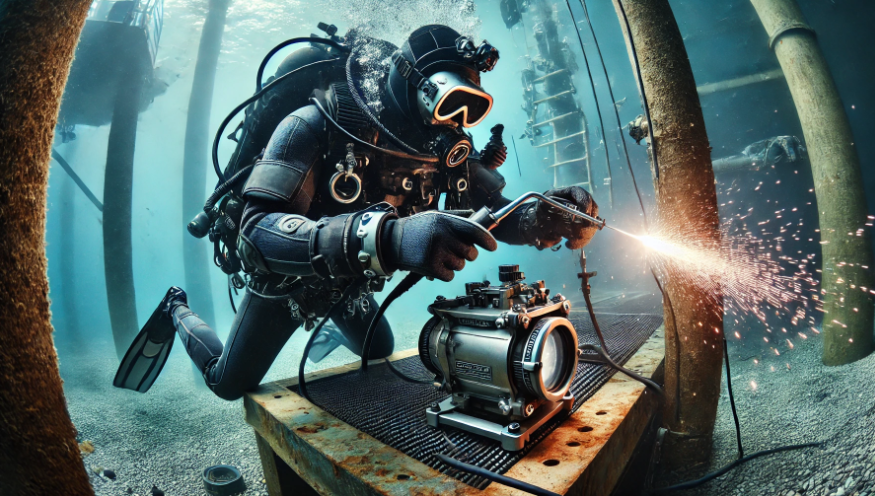
Average Salary: $54,000 – $93,000 per year
Commercial Divers are the fearless professionals who work in the depths of the ocean, performing critical tasks such as underwater construction, inspection, and salvage operations.
This challenging and rewarding career is perfect for adrenaline seekers who are comfortable working in high-pressure environments and have a passion for the underwater world.
Job Duties:
- Underwater Construction: Perform a variety of underwater construction tasks, such as welding, cutting, and installing pipelines, platforms, and other structures.
- Inspection and Maintenance: Conduct visual inspections, non-destructive testing, and maintenance on underwater structures, such as bridges, dams, and offshore oil rigs.
- Salvage Operations: Participate in salvage operations to recover sunken vessels, lost cargo, or other valuable assets from the ocean floor.
- Hazardous Materials Handling: Work with and remove hazardous materials, such as unexploded ordnance or contaminated sediments, from underwater sites.
- Equipment Operation: Operate specialized underwater tools and equipment, such as hydraulic power tools, lift bags, and remotely operated vehicles (ROVs).
- Dive Planning and Safety: Develop detailed dive plans, conduct pre-dive safety checks, and adhere to strict safety protocols to minimize the risks associated with working underwater.
Requirements:
- Commercial Diving Certification: Completion of a recognized commercial diving training program, such as the Association of Diving Contractors International (ADCI) or the International Marine Contractors Association (IMCA).
- Physical Fitness: Excellent physical condition and the ability to perform demanding work in challenging underwater environments.
- Technical Skills: Proficiency in various underwater construction and inspection techniques, such as welding, cutting, and non-destructive testing.
- Problem-Solving Abilities: Strong problem-solving skills and the ability to think critically and adapt to changing conditions underwater.
- Teamwork and Communication: Ability to work effectively as part of a dive team and communicate clearly using dive signals and underwater communication systems.
- Attention to Detail: Meticulous attention to detail and a commitment to quality workmanship in all underwater tasks.
Career Path and Growth:
Commercial Divers often begin their careers by completing a comprehensive commercial diving training program and gaining experience through entry-level positions in the industry.
With experience and demonstrated proficiency, divers may advance to roles such as dive supervisor, project manager, or underwater welding specialist.
Some Commercial Divers may also transition to related fields, such as ROV operation, hyperbaric medicine, or marine engineering, leveraging their unique skills and knowledge to expand their career opportunities.
16. Adventure Guide

Average Salary: $26,000 – $40,000 per year
Adventure Guides are the intrepid leaders who help others experience the thrill and beauty of the great outdoors through guided expeditions and activities.
This exciting and rewarding career is ideal for adrenaline seekers who have a passion for nature, a love of adventure, and a desire to share their knowledge and enthusiasm with others.
Job Duties:
- Leading Outdoor Activities: Guide clients through a variety of outdoor adventures, such as hiking, rock climbing, whitewater rafting, or backcountry skiing.
- Teaching Skills and Techniques: Instruct participants in the proper techniques, safety procedures, and use of equipment for each activity.
- Ensuring Safety: Monitor weather conditions, assess potential hazards, and make critical decisions to ensure the safety and well-being of all participants.
- Providing Natural Interpretation: Share knowledge about the local environment, including flora, fauna, geology, and history, to enhance the participants’ appreciation and understanding of the area.
- Equipment Maintenance: Inspect, maintain, and repair outdoor gear and equipment to ensure it is in proper working condition for each expedition.
- Trip Planning and Logistics: Plan and organize trips, including route selection, permitting, transportation, and meal preparation.
Requirements:
- Outdoor Expertise: Extensive knowledge and experience in the specific outdoor activities offered, often gained through personal pursuits and professional certifications.
- Safety Certifications: Relevant certifications in wilderness first aid, CPR, and activity-specific safety training.
- Physical Fitness: Excellent physical condition and the ability to lead and participate in strenuous outdoor activities in varying conditions.
- Leadership Skills: Strong leadership abilities, including decision-making, problem-solving, and group management skills.
- Interpersonal Skills: Excellent communication and interpersonal skills for interacting with clients, building rapport, and fostering a positive group dynamic.
- Environmental Stewardship: Commitment to environmental ethics and Leave No Trace principles to minimize the impact of outdoor activities on natural resources.
Career Path and Growth:
Adventure Guides often begin their careers as enthusiastic outdoor recreationists, gaining experience and honing their skills through personal adventures and volunteer work.
With experience and certifications, guides may advance to lead guide positions, taking on greater responsibilities and guiding more complex or technical expeditions.
Some Adventure Guides may also start their own guiding businesses, specializing in specific activities or regions, or transition to roles in outdoor education, park management, or adventure tourism.
15. High-Rise Construction Worker

Average Salary: $45,000 – $75,000 per year
High-Rise Construction Workers are the fearless individuals who build the towering skyscrapers that define city skylines around the world.
This challenging and exciting career is perfect for adrenaline seekers who thrive on working at dizzying heights and take pride in creating iconic structures that shape the urban landscape.
Job Duties:
- Structural Work: Erect steel frameworks, install prefabricated components, and construct concrete forms to build the skeleton of high-rise buildings.
- Exterior Finishing: Install exterior cladding, windows, and façade elements to complete the outer shell of the building.
- Rigging and Hoisting: Operate cranes, hoists, and other lifting equipment to move materials and equipment to high elevations.
- Safety Procedures: Follow strict safety protocols, including the use of personal protective equipment, fall arrest systems, and adherence to OSHA regulations.
- Teamwork and Communication: Work collaboratively with other construction professionals, such as engineers, architects, and supervisors, to ensure efficient and safe project completion.
- Physical Labor: Perform demanding physical tasks, such as lifting, carrying, and maneuvering heavy materials and equipment at great heights.
Requirements:
- Construction Experience: Prior experience in construction, preferably in high-rise or commercial building projects.
- Technical Skills: Proficiency in various construction trades, such as ironwork, welding, or carpentry, depending on the specific role.
- Physical Fitness: Excellent physical condition and stamina to perform demanding work at high elevations for extended periods.
- Comfort with Heights: Ability to work comfortably and safely at great heights, often hundreds of feet above the ground.
- Safety Consciousness: Strong commitment to safety protocols and a keen awareness of potential hazards in the work environment.
- Problem-Solving Skills: Ability to think critically, adapt to challenges, and find creative solutions to overcome obstacles in the construction process.
Career Path and Growth:
High-Rise Construction Workers often begin their careers as apprentices or entry-level laborers, learning the skills and techniques of their trade through on-the-job training and mentorship.
With experience and demonstrated proficiency, workers may advance to roles such as lead ironworker, crane operator, or construction superintendent, taking on greater responsibilities and overseeing larger aspects of the project.
Some High-Rise Construction Workers may also specialize in specific areas, such as welding, rigging, or safety
inspection, becoming experts in their field and sought-after professionals in the industry.
14. Combat Medic

Average Salary: $40,000 – $60,000 per year
Combat Medics are the brave men and women who provide critical medical care on the battlefield, often in the face of enemy fire and harsh conditions.
This challenging and rewarding career is ideal for adrenaline seekers with a strong desire to serve their country, save lives, and make a difference in the world.
Job Duties:
- Providing Emergency Care: Administer life-saving medical treatment to wounded soldiers in combat situations, including trauma care, triage, and evacuation.
- Field Medicine: Perform advanced medical procedures in austere environments, such as surgical interventions, intravenous therapy, and medication administration.
- Medical Logistics: Manage and maintain medical supplies and equipment, ensuring that essential resources are available when needed.
- Training and Education: Provide medical training and education to fellow soldiers, teaching basic first aid and combat lifesaver skills.
- Physical Conditioning: Maintain a high level of physical fitness to endure the demands of combat operations and carry heavy medical equipment.
- Collaboration with Medical Teams: Work closely with other healthcare professionals, such as physicians and nurses, to provide comprehensive care and ensure continuity of treatment.
Requirements:
- Military Training: Completion of basic military training and specific training for combat medic roles, such as the Army’s 68W Healthcare Specialist course.
- Medical Certifications: Certification as an Emergency Medical Technician (EMT) or Paramedic, with additional training in battlefield medicine and trauma care.
- Physical Fitness: Excellent physical condition and the ability to perform demanding tasks in high-stress environments.
- Mental Resilience: Strong mental and emotional resilience to cope with the challenges and trauma of combat situations.
- Adaptability: Ability to adapt to rapidly changing situations, think critically, and make quick decisions under pressure.
- Teamwork and Leadership: Strong teamwork skills and the ability to lead and motivate others in high-stakes situations.
Career Path and Growth:
Combat Medics typically begin their careers by enlisting in the military and completing basic training followed by specialized medical training.
With experience and demonstrated proficiency, Combat Medics may advance to leadership positions, such as squad leader or platoon sergeant, taking on additional responsibilities and mentoring junior medics.
After completing their military service, many Combat Medics transition to civilian healthcare roles, such as paramedic, emergency room technician, or physician assistant, leveraging their unique skills and experience to continue serving others.
13. Trauma Surgeon

Average Salary: $200,000 – $500,000 per year
Trauma Surgeons are the last line of defense for critically injured patients, working tirelessly to save lives in the face of devastating injuries and time-sensitive conditions.
This intense and emotionally demanding career is ideal for adrenaline seekers with exceptional medical skills, quick decision-making abilities, and the mental fortitude to handle high-pressure situations.
Job Duties:
- Emergency Surgery: Perform life-saving surgical procedures on patients with traumatic injuries, such as gunshot wounds, stab wounds, or injuries from car accidents.
- Patient Assessment and Triage: Quickly assess the severity of a patient’s injuries, prioritize treatment, and coordinate with other medical professionals to ensure optimal care.
- Post-Operative Care: Monitor patients’ recovery after surgery, managing complications and adjusting treatment plans as needed.
- Trauma Team Leadership: Lead and coordinate the efforts of the trauma team, including other surgeons, nurses, and support staff, to provide comprehensive care for critically injured patients.
- Research and Education: Participate in research projects to advance the field of trauma surgery and educate other medical professionals and the public about injury prevention and treatment.
- Quality Improvement: Continuously evaluate and improve trauma care protocols and procedures to optimize patient outcomes and ensure the highest standards of care.
Requirements:
- Medical Education: Completion of a four-year undergraduate degree, followed by a four-year medical school program and a five-year general surgery residency.
- Trauma Surgery Fellowship: Additional one-to-two-year fellowship training in trauma surgery to develop specialized skills and expertise.
- Surgical Skills: Exceptional surgical abilities and the ability to perform a wide range of complex procedures under high-pressure conditions.
- Rapid Decision-Making: Ability to quickly assess a patient’s condition, determine the best course of action, and make critical decisions with limited information.
- Emotional Resilience: Mental and emotional strength to cope with the high-stress environment, long hours, and emotionally challenging cases.
- Leadership and Communication: Strong leadership skills to coordinate and direct the efforts of the trauma team, as well as clear communication abilities to interact with patients, families, and other medical professionals.
Career Path and Growth:
Trauma Surgeons often begin their careers as general surgeons, gaining experience in a wide range of surgical procedures before specializing in trauma surgery through fellowship training.
With experience and demonstrated expertise, Trauma Surgeons may advance to leadership positions, such as Trauma Medical Director or Chief of Trauma, overseeing the operations and quality of a hospital’s trauma program.
Some Trauma Surgeons may also pursue academic careers, combining clinical practice with research and teaching responsibilities at medical schools or teaching hospitals.
12. Air Traffic Controller
Average Salary: $70,000 – $140,000 per year
Air Traffic Controllers are the unseen guardians of the skies, responsible for the safe and efficient movement of aircraft through the nation’s airspace.
This high-pressure career is perfect for adrenaline seekers with excellent spatial awareness, quick decision-making skills, and the ability to remain calm under stress.
Job Duties:
- Managing Air Traffic: Monitor and direct the movement of aircraft on the ground and in the air, ensuring safe separation and efficient traffic flow.
- Issuing Instructions: Provide pilots with takeoff and landing instructions, weather updates, and other critical information to ensure safe operations.
- Coordinating with Other Controllers: Work closely with other controllers to manage traffic flow between sectors and airports, handing off aircraft as they move through different airspaces.
- Responding to Emergencies: Make quick and decisive actions to manage aircraft emergencies, such as malfunctions or medical situations, prioritizing safety and coordinating with emergency services.
- Maintaining Situational Awareness: Constantly monitor weather conditions, runway status, and other factors that may impact air traffic operations.
- Keeping Detailed Records: Maintain accurate logs and reports of air traffic activities, including any incidents or deviations from standard procedures.
Requirements:
- Spatial Awareness and Visualization: Excellent ability to visualize and understand three-dimensional space and the relative positions of aircraft.
- Quick Decision-Making: Ability to make rapid, accurate decisions in high-pressure situations, prioritizing safety and efficiency.
- Concentration and Multi-Tasking: Exceptional focus and the ability to manage multiple tasks and sources of information simultaneously.
- Communication Skills: Clear, concise, and assertive communication abilities to convey instructions and information to pilots and other controllers.
- Stress Management: Ability to remain calm and maintain composure in high-stress situations, adapting to changing conditions and emergencies.
- Problem-Solving: Quick thinking and the ability to identify and resolve potential conflicts or safety issues before they escalate.
Career Path and Growth:
Air Traffic Controllers typically begin their careers working in lower-volume facilities or sectors, gradually progressing to busier and more complex airspaces as they gain experience.
With time and demonstrated proficiency, controllers may advance to supervisory positions or take on additional responsibilities, such as training new controllers or participating in the development of air traffic control procedures and technologies.
Some experienced controllers may also transition to related fields, such as aviation consulting or airport management.
11. Military Personnel (Combat Roles)
Average Salary: $40,000 – $100,000 per year
Military Personnel in combat roles are the bold protectors of national security, engaging in high-stakes missions and operations around the world.
This challenging and dynamic career path is ideal for adrenaline seekers with a strong sense of duty, discipline, and a willingness to serve their country.
Job Duties:
- Combat Operations: Participate in offensive and defensive military operations, employing a wide range of tactics and weapons systems.
- Tactical Planning: Develop and execute mission plans, adapting to changing battlefield conditions and enemy threats.
- Weapons Proficiency: Maintain and employ a variety of weapons systems, from small arms to heavy artillery, with skill and precision.
- Physical Conditioning: Engage in rigorous physical training and maintain peak fitness levels to meet the demands of combat operations.
- Teamwork and Leadership: Work effectively as part of a cohesive unit, following orders and demonstrating leadership when called upon.
- Specialized Roles: Serve in specialized combat roles, such as infantry, special operations, or armored units, depending on individual skills and training.
Requirements:
- Physical and Mental Fitness: Exceptional physical condition and mental resilience to withstand the rigors of combat and high-stress situations.
- Military Training: Completion of basic military training and specialized training for specific combat roles, such as infantry school or airborne training.
- Weapons Proficiency: Mastery of assigned weapons systems and the ability to employ them effectively in combat situations.
- Adaptability and Problem-Solving: Ability to think on one’s feet, adapt to rapidly changing situations, and make critical decisions under pressure.
- Teamwork and Communication: Strong ability to work as part of a coordinated team, communicating effectively and following orders in high-stakes environments.
- Discipline and Integrity: Unwavering commitment to military values, discipline, and the highest standards of personal and professional conduct.
Career Path and Growth:
Military Personnel can advance through the ranks to become non-commissioned officers (NCOs) or commissioned officers, taking on increasing levels of responsibility and leadership.
Some may choose to specialize in specific combat roles or transition to support roles, such as intelligence or logistics.
After completing their military service, many veterans leverage their skills and experience to pursue careers in law enforcement, private security, or government agencies.
10. Race Car Driver

Average Salary: $40,000 – $200,00+ per year
Race Car Drivers are the daring athletes who push themselves and their vehicles to the limit, competing in high-speed events on tracks around the world.
This fast-paced and competitive career is ideal for adrenaline seekers with exceptional driving skills, quick reflexes, and the mental fortitude to perform under pressure.
Job Duties:
- Competing in Races: Participate in various racing events, such as NASCAR, Formula One, or IndyCar, striving to outperform competitors and achieve victory.
- Practicing and Testing: Spend countless hours practicing on the track and working with the team to fine-tune the car’s performance and develop race strategies.
- Physical Conditioning: Maintain peak physical fitness through rigorous training programs to withstand the high G-forces and mental demands of racing.
- Sponsorship and Media: Secure sponsorships, participate in media interviews and promotional events, and maintain a positive public image.
- Collaborating with Team: Work closely with engineers, mechanics, and other team members to analyze data, provide feedback, and continually improve the car’s performance.
- Safety and Regulations: Adhere to strict safety protocols and regulations, participating in safety briefings and ensuring compliance with all racing rules and guidelines.
Requirements:
- Driving Skills: Exceptional car control, quick reflexes, and the ability to make split-second decisions at high speeds.
- Racing Experience: Extensive experience in competitive racing, often starting from a young age in karting or junior racing categories.
- Physical Fitness: High level of physical fitness, including strength, endurance, and cardiovascular conditioning, to withstand the demands of racing.
- Technical Knowledge: Understanding of vehicle mechanics, aerodynamics, and racing strategies to effectively communicate with the team and optimize performance.
- Mental Resilience: Ability to maintain focus, manage stress, and perform under pressure in high-stakes competitions.
- Sponsorship and Marketing: Strong interpersonal skills and the ability to attract and maintain sponsorships and media relationships.
Career Path and Growth:
Aspiring Race Car Drivers often begin their careers in karting or junior racing categories, honing their skills and gaining experience before progressing to higher levels of competition.
With success on the track and the ability to secure sponsorships, drivers may advance to more prestigious racing leagues, such as NASCAR or Formula One.
Experienced drivers may also transition to team management or driver coaching roles, sharing their knowledge and expertise with the next generation of racers.
9. EMT / Paramedic
Average Salary: $35,000 – $60,000 per year
EMTs (Emergency Medical Technicians) and Paramedics are the first responders to medical emergencies, providing critical care and transportation to hospitals for patients in need.
This fast-paced and rewarding career is perfect for adrenaline seekers with a passion for helping others and the ability to think quickly in high-pressure situations.
Job Duties:
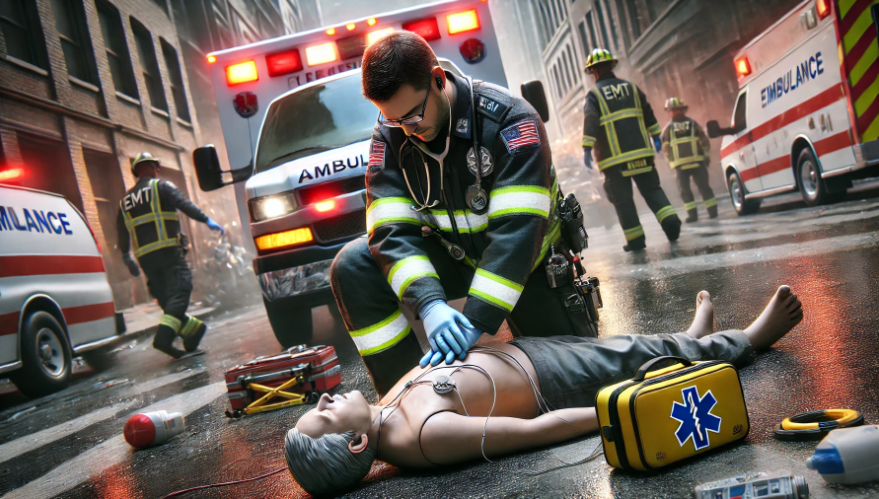
- Emergency Response: Respond to 911 calls and quickly assess the scene and the patient’s condition to determine the appropriate course of action.
- Patient Assessment and Treatment: Conduct physical exams, take vital signs, and provide essential treatments such as CPR, wound care, and medication administration.
- Patient Transport: Safely transport patients to hospitals or other medical facilities, monitoring their condition and providing ongoing care during the journey.
- Documentation and Reporting: Maintain accurate patient care reports and documentation, communicating pertinent information to hospital staff upon arrival.
- Equipment Maintenance: Ensure that all medical equipment and supplies are properly stocked, maintained, and in good working condition.
- Continuous Education: Participate in ongoing training and education to stay current with the latest emergency medical techniques, protocols, and technologies.
Requirements:
- EMT or Paramedic Certification: Completion of a state-approved EMT or Paramedic training program, which includes classroom instruction, clinical rotations, and practical skills training.
- Licensure: Successful completion of the National Registry of Emergency Medical Technicians (NREMT) exam and state-specific licensure requirements.
- Physical Fitness: Good physical condition and the ability to lift, carry, and move patients and equipment in a variety of settings.
- Quick Decision-Making: Ability to rapidly assess a patient’s condition and make critical decisions under pressure, often with limited information.
- Compassion and Empathy: Strong interpersonal skills and the ability to provide compassionate care and emotional support to patients and their families during crisis situations.
- Teamwork and Communication: Ability to work effectively as part of a team, communicating clearly with other first responders, medical professionals, and patients.
Career Path and Growth:
Many EMTs begin their careers in entry-level positions, gaining valuable experience in the field before advancing to higher levels of certification, such as Advanced EMT or Paramedic.
With experience and additional training, EMTs and Paramedics may specialize in areas such as critical care transport, flight medicine, or tactical emergency medical support.
Some may also transition to related healthcare fields, such as nursing or physician assistant, or pursue leadership roles in emergency medical services, such as supervisor or training coordinator positions.
8. Police Officer / SWAT Team Member

Average Salary: $60,000 – $90,000 per year
Police Officers and SWAT Team Members are the frontline defenders of public safety, tasked with maintaining order, responding to emergencies, and apprehending dangerous criminals.
This high-stakes career is perfect for adrenaline seekers with a strong sense of justice and a commitment to serving their communities.
Job Duties:
- Patrolling and Responding to Calls: Monitor assigned areas, respond to emergency calls, and investigate suspicious activities or crimes in progress.
- Law Enforcement: Enforce local, state, and federal laws, issuing citations, making arrests, and testifying in court as needed.
- Crisis Intervention: De-escalate high-tension situations, such as domestic disputes or mental health crises, using communication and negotiation skills.
- Evidence Collection and Documentation: Gather and preserve evidence at crime scenes, interview witnesses, and maintain detailed reports and records.
- Community Engagement: Build positive relationships with community members, participating in outreach programs and providing public safety education.
- SWAT Operations (Specialized): Execute high-risk warrants, respond to hostage situations, and engage in tactical operations as part of a specialized SWAT team.
Requirements:
- Physical Fitness: Excellent physical condition and the ability to pass rigorous fitness tests, including strength, endurance, and agility assessments.
- Law Enforcement Training: Completion of a police academy program, which includes classroom instruction and practical training in law enforcement techniques, defensive tactics, and firearms proficiency.
- Legal Knowledge: Thorough understanding of local, state, and federal laws, as well as constitutional rights and police procedures.
- Communication and Interpersonal Skills: Ability to communicate effectively with a diverse range of individuals, often in high-stress situations, and maintain a professional demeanor.
- Decision-Making and Problem-Solving: Quick thinking and sound judgment to assess complex situations and make critical decisions under pressure.
- Integrity and Ethics: Strong moral character and a commitment to upholding the law and serving the public with integrity and impartiality.
Career Path and Growth:
Police Officers can advance through the ranks to become detectives, sergeants, or lieutenants, taking on increased investigative and supervisory responsibilities.
Some may choose to specialize in areas such as narcotics, gang units, or K-9 handling, or join specialized
teams like SWAT or bomb squads.
With additional education and experience, Police Officers may also transition into related fields, such as private security, criminal justice, or law enforcement training and education.
7. Firefighter
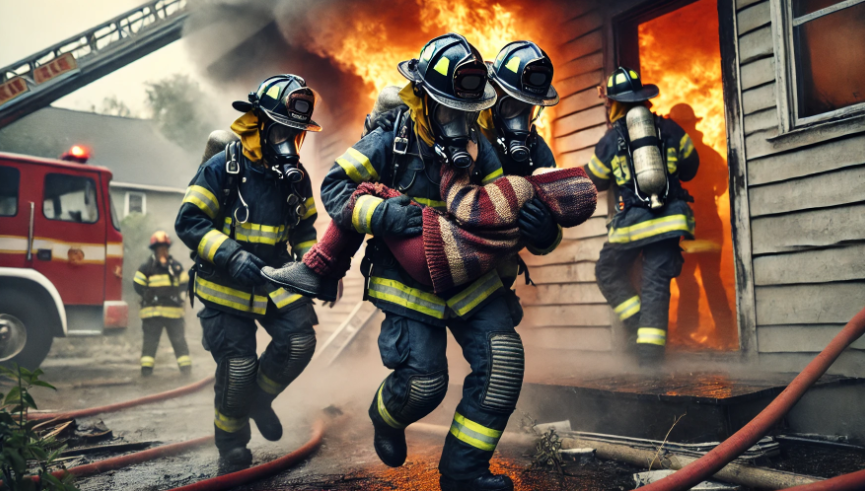
Average Salary: $50,000 – $70,000 per year
Firefighters are the epitome of bravery, rushing into burning buildings and hazardous situations to save lives and protect property.
This physically demanding and emotionally rewarding career is ideal for adrenaline seekers with a strong sense of duty and a desire to serve their communities.
Job Duties:
- Emergency Response: Respond to fire alarms and emergency calls, arriving quickly on the scene to assess the situation and take appropriate action.
- Fire Suppression: Use a variety of tools and techniques to extinguish fires, including hoses, pumps, and fire extinguishers.
- Rescue Operations: Enter burning buildings or other hazardous areas to search for and rescue trapped or injured individuals, often in challenging and low-visibility conditions.
- Medical Assistance: Provide basic emergency medical care to victims until paramedics arrive, including CPR and first aid.
- Hazardous Materials Handling: Respond to incidents involving hazardous materials, working to contain spills and protect the public from potential harm.
- Fire Prevention and Education: Participate in fire prevention initiatives, such as conducting building inspections and educating the public about fire safety.
Requirements:
- Physical Fitness: Excellent physical condition and the ability to pass rigorous fitness tests, including strength, endurance, and agility assessments.
- Emergency Medical Training: Certification as an Emergency Medical Technician (EMT) or paramedic to provide basic life support services.
- Firefighting Education: Completion of a fire academy program, which includes classroom instruction and practical training in firefighting techniques, equipment usage, and safety protocols.
- Teamwork and Communication: Strong ability to work as part of a coordinated team, communicating effectively under high-stress conditions.
- Adaptability and Problem-Solving: Quick thinking and the ability to adapt to rapidly changing situations, making critical decisions in the face of uncertainty.
- Emotional Resilience: Mental and emotional strength to cope with traumatic situations and maintain composure under pressure.
Career Path and Growth:
Firefighters can advance through the ranks to become lieutenants, captains, or even fire chiefs, taking on increasing levels of responsibility and leadership.
Some may choose to specialize in areas such as arson investigation, hazardous materials response, or wildland firefighting.
With additional education and experience, firefighters may also transition into related fields, such as emergency management or fire protection engineering.
6. Bull Rider
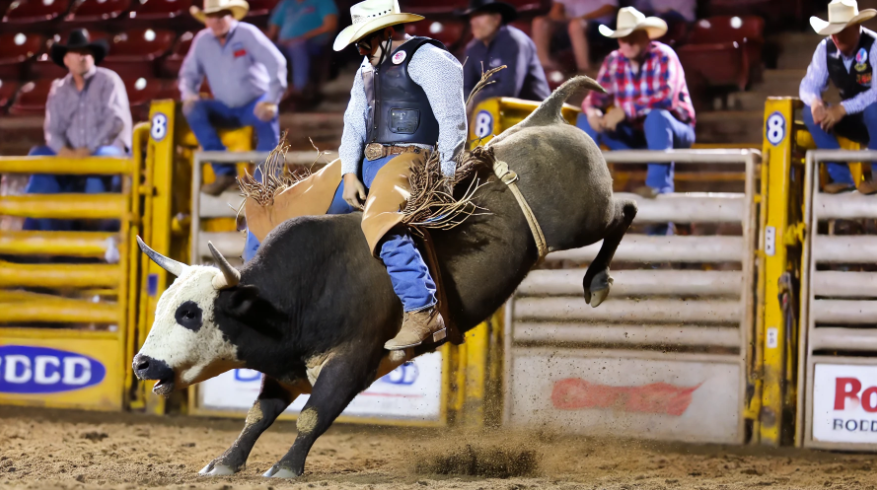
Average Salary: $30,000 – $50,000 per year
Bull Riders are the fearless cowboys who take on the challenge of staying atop a bucking, spinning bull for a heart-stopping eight seconds.
This high-risk, high-reward career is perfect for adrenaline seekers with nerves of steel, lightning-fast reflexes, and an unwavering commitment to the sport.
Job Duties:
- Competing in Rodeos: Participate in bull riding events at rodeos across the country, striving to achieve the highest scores and win prize money.
- Training and Conditioning: Engage in regular strength training, cardiovascular exercise, and flexibility work to maintain peak physical condition and reduce the risk of injury.
- Equipment Maintenance: Ensure that all bull riding equipment, such as ropes, gloves, and protective gear, is properly maintained and in good condition.
- Livestock Care: Assist with the care and handling of the bulls, ensuring their health and well-being before and after competitions.
- Sponsorship and Promotion: Secure sponsorships from companies within the rodeo industry and participate in promotional events and interviews.
- Mentoring and Coaching: Share knowledge and experience with younger riders, offering guidance and support as they develop their skills and pursue their dreams.
Requirements:
- Bull Riding Experience: Extensive experience in bull riding, often gained through years of practice and competition at amateur and semi-professional levels.
- Physical Strength and Flexibility: Exceptional physical strength, particularly in the core and legs, as well as flexibility to maintain control and absorb the shock of the bull’s movements.
- Quick Reflexes: Lightning-fast reflexes and the ability to make split-second decisions to anticipate and react to the bull’s movements.
- Mental Toughness: Unwavering mental toughness and the ability to overcome fear, focus on the task at hand, and persevere through setbacks and injuries.
- Rodeo Knowledge: Understanding of rodeo rules, scoring systems, and livestock handling protocols to compete effectively and ensure the safety of both riders and animals.
- Interpersonal Skills: Strong communication and interpersonal skills for interacting with sponsors, media, and fellow competitors.
Career Path and Growth:
Most Bull Riders begin their careers at a young age, participating in youth rodeo events and honing their skills through years of practice and dedication.
As they progress and achieve success at amateur and semi-professional levels, riders may earn invitations to compete in top-tier events, such as the Professional Bull Riders (PBR) tour.
Experienced riders may also transition to roles such as bull riding coach, event coordinator, or rodeo broadcaster, sharing their knowledge and passion for the sport with others.
5. Professional Skydiver

Average Salary: $30,000 – $50,000 per year
Professional Skydivers turn their passion for the thrill of freefall into a career, performing for audiences, competing in events, and teaching others to experience the rush of jumping from an airplane.
This exhilarating career is perfect for adrenaline seekers who love the freedom of flight and the challenge of mastering advanced aerial maneuvers.
Job Duties:
- Performing Skydives: Execute solo or group skydives for demonstrations, competitions, or entertainment purposes, showcasing advanced skills and choreography.
- Teaching and Coaching: Instruct students in skydiving techniques, safety procedures, and equipment use, guiding them through their first jumps and helping them develop their skills.
- Equipment Maintenance: Inspect, maintain, and pack parachutes and other skydiving equipment to ensure proper function and safety.
- Safety Procedures: Adhere to strict safety protocols and regulations, conducting pre-jump briefings and ensuring that all participants follow established guidelines.
- Marketing and Promotion: Promote skydiving services, events, and competitions through social media, websites, and other marketing channels.
- Networking and Event Planning: Build relationships with other skydivers, participate in industry events, and help organize skydiving competitions and festivals.
Requirements:
- Skydiving Certification: Completion of a comprehensive skydiving training program, including classroom instruction, practical training, and a minimum number of solo jumps.
- Instructor Ratings: Additional certifications and ratings, such as Accelerated Freefall Instructor or Tandem Instructor, for those who wish to teach skydiving.
- Physical Fitness: Excellent physical condition and the ability to perform demanding aerial maneuvers and landings.
- Attention to Detail: Meticulous attention to safety procedures, equipment maintenance, and pre-jump planning to minimize risks.
- Interpersonal Skills: Strong communication and customer service skills for interacting with students, clients, and fellow skydivers.
- Adaptability: Ability to adjust to changing weather conditions, equipment issues, or unexpected situations while maintaining a calm and professional demeanor.
Career Path and Growth:
Professional Skydivers often begin their careers as passionate hobbyists, accumulating experience and developing their skills before transitioning to paid positions.
With experience and additional certifications, skydivers may advance to roles such as senior instructor, dropzone manager, or event coordinator.
Some Professional Skydivers may also specialize in specific disciplines, such as freestyle, formation skydiving, or wingsuit flying, and compete at national and international levels.
4. Extreme Sports Instructor
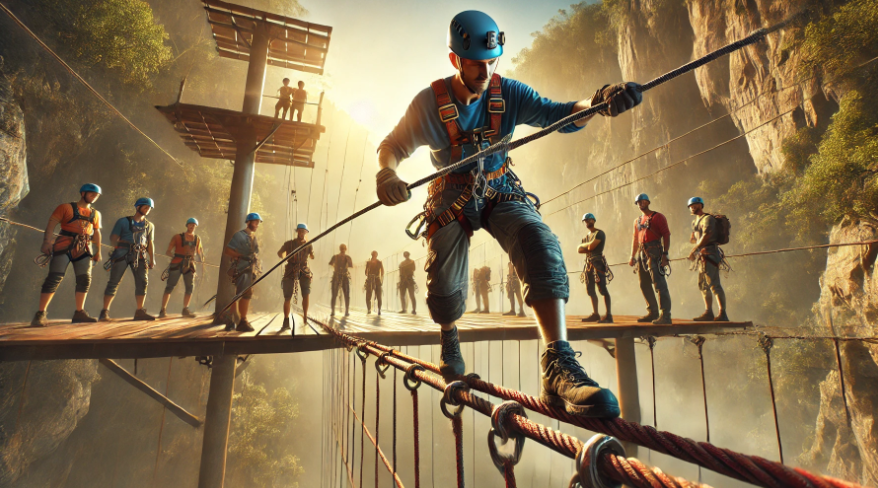
Average Salary: $30,000 – $80,000 per year
Extreme Sports Instructors combine their passion for adrenaline-pumping activities with the rewarding experience of teaching others to push their limits and conquer new challenges.
This career path is perfect for thrill-seekers who want to share their love of extreme sports with enthusiastic students.
Job Duties:
- Teaching and Guiding: Provide expert instruction and guidance to individuals or groups participating in extreme sports activities, such as skydiving, rock climbing, or surfing.
- Ensuring Safety: Prioritize safety by conducting thorough equipment checks, assessing weather and environmental conditions, and enforcing proper techniques and protocols.
- Developing Lesson Plans: Create and implement lesson plans tailored to the skill levels and goals of each student or group.
- Demonstrating Techniques: Showcase proper form and techniques for various maneuvers and skills, providing clear explanations and demonstrations.
- Evaluating Progress: Monitor student progress, offer constructive feedback, and adjust teaching methods as needed to ensure continued growth and improvement.
- Maintaining Equipment: Regularly inspect, maintain, and repair equipment to ensure it is in safe working condition for use by students and instructors.
Requirements:
- Expertise in Extreme Sports: Extensive experience and mastery in the specific extreme sport you wish to instruct, often backed by professional certifications.
- Instructional Skills: Strong communication and teaching abilities to effectively convey techniques, concepts, and safety procedures to students of varying skill levels.
- Safety Certifications: Relevant safety certifications, such as first aid, CPR, or wilderness first responder, to handle potential emergencies.
- Physical Fitness: Excellent physical condition and the ability to demonstrate and perform the skills being taught.
- Patience and Empathy: Ability to remain patient, supportive, and encouraging when working with students who may be facing fears or challenges.
- Risk Assessment: Keen understanding of risk management and the ability to make sound judgments to ensure the safety of all participants.
Career Path and Growth:
As Extreme Sports Instructors gain experience and build their reputation, they may advance to lead instructor or program director positions within their organizations.
Some may choose to specialize in a particular discipline or start their own extreme sports schools or guide services.
Experienced instructors may also have opportunities to become brand ambassadors for outdoor gear companies, or pursue careers in event planning and management within the extreme sports industry.
3. Search and Rescue Operator
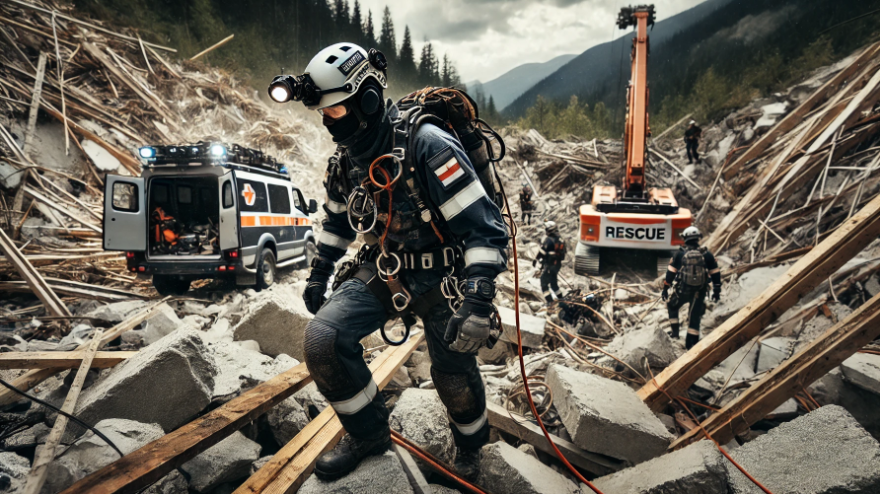
Average Salary: $40,000 – $60,000+ per year
Search and Rescue Operators bravely venture into dangerous terrain and challenging conditions to locate and save individuals who are lost, injured, or stranded.
This career is ideal for adrenaline seekers with a strong sense of compassion and a desire to help others in need.
Job Duties:
- Conducting Rescue Missions: Lead search operations in various environments, such as mountains, forests, and bodies of water, to find and rescue missing or distressed individuals.
- Providing Emergency Care: Administer first aid and emergency medical treatment to injured or ill persons until they can be transported to a medical facility.
- Operating Specialized Equipment: Utilize and maintain rescue equipment, including helicopters, boats, all-terrain vehicles, and climbing gear.
- Navigate Challenging Terrain: Traverse difficult and hazardous terrain, often in adverse weather conditions, to reach and evacuate those in need.
- Collaborating with Other Agencies: Work closely with law enforcement, medical personnel, and other agencies during rescue operations and investigations.
- Maintaining Readiness: Engage in regular training exercises and maintain physical fitness to ensure peak performance during rescue missions.
Requirements:
- Physical Fitness: Excellent physical condition and endurance to navigate challenging terrain and perform demanding rescues.
- Technical Skills: Proficiency in a variety of rescue techniques, such as rope systems, swift-water rescue, and wilderness survival.
- Medical Training: Certification in emergency medical care, such as EMT or paramedic, to provide life-saving treatment in the field.
- Navigation and Orienteering: Strong navigation skills and the ability to read maps, use compasses, and navigate using GPS systems.
- Problem-Solving: Quick thinking and adaptability to make critical decisions in high-pressure situations.
- Teamwork: Ability to work effectively as part of a coordinated rescue team and communicate clearly under stress.
Career Path and Growth:
Search and Rescue Operators can advance to leadership positions within their organizations, such as team leader or mission coordinator.
Some may choose to specialize in specific areas, such as mountain rescue or underwater recovery, or pursue careers in related fields like emergency management or outdoor education.
With experience and additional training, Search and Rescue Operators may also transition into roles as instructors or consultants, sharing their expertise with others in the field.
2. Stunt Performer

Average Salary: $70,000 – $100,000 per year
Stunt Performers execute thrilling and often dangerous physical feats for movies, television, and live entertainment, ensuring the stars look heroic and the action remains realistic.
This role is perfect for adrenaline seekers who have a passion for physical challenges and the film industry.
Job Duties:
- Performing Stunts: Execute a wide range of physical stunts, including fight scenes, high falls, car chases, and fire burns, ensuring they are carried out safely and convincingly.
- Choreographing Action Sequences: Work with directors and stunt coordinators to create engaging and dynamic action sequences that align with the creative vision of the production.
- Training and Fitness: Maintain a high level of physical fitness and continually train in various disciplines such as martial arts, driving, acrobatics, or other relevant skills.
- Preparation and Safety: Rig and test stunt equipment, attend safety briefings, and ensure all precautions are taken to minimize risk of injury.
- Collaborating with Production Crew: Work closely with costume designers, special effects teams, and other departments to ensure stunts are integrated seamlessly into the production.
- Rehearsals: Participate in rehearsals to perfect stunts and ensure they are executed consistently during filming or live performances.
Requirements:
- Physical Fitness: Exceptional physical condition and athleticism are essential for performing demanding stunts.
- Specialized Training: Proficiency in various stunt-related disciplines, such as martial arts, gymnastics, driving, or horseback riding.
- Experience: Prior experience in sports, martial arts, or physical performance arts can be beneficial.
- Risk Management: Understanding of safety procedures and risk assessment to minimize the likelihood of accidents.
- Adaptability: Ability to quickly adapt to different stunts, environments, and production changes.
- Teamwork: Strong collaborative skills to work effectively with stunt coordinators and other team members.
Career Path and Growth:
Stunt Performing is a career that provides an adrenaline rush while contributing to some of the most iconic moments in entertainment.
With experience, Stunt Performers can become Stunt Coordinators, overseeing entire stunt departments and designing complex action sequences.
They may also specialize in a particular type of stunt work or become trainers for aspiring stunt performers.
1. Storm Chaser
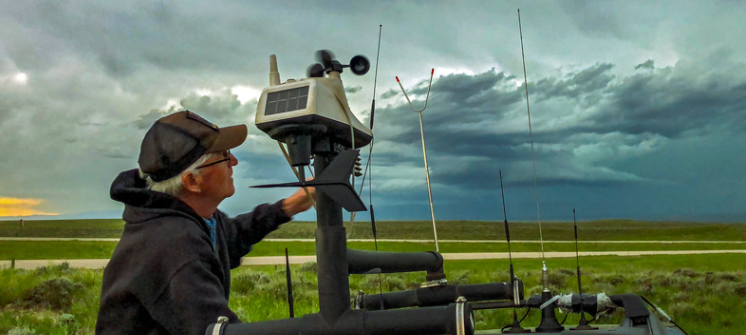
Average Salary: $40,000 – $70,000 per year
Storm Chasers are the daring individuals who brave severe weather conditions to gather critical data and provide real-time updates on storms, tornadoes, and hurricanes.
This exhilarating and unpredictable career is ideal for adrenaline seekers with a passion for weather science and the willingness to face nature’s fury head-on.
Job Duties:
- Tracking and Forecasting: Monitor weather patterns, radar data, and computer models to predict the development and movement of severe storms.
- Field Research: Deploy to storm sites to gather data, take photographs, and record video footage of severe weather events for scientific analysis and public information.
- Equipment Maintenance: Ensure that all storm chasing equipment, such as cameras, weather sensors, and communication devices, are properly maintained and in good working condition.
- Data Analysis: Analyze collected data to contribute to the understanding of severe weather phenomena and improve forecasting models.
- Public Education: Provide educational presentations and workshops to inform the public about severe weather safety and preparedness.
- Media Collaboration: Work with media outlets to provide expert commentary, photos, and video footage of severe weather events for news broadcasts and documentaries.
Requirements:
- Meteorology Education: A bachelor’s degree in meteorology, atmospheric science, or a related field is often required for professional storm chasing positions.
- Storm Chasing Experience: Practical experience in storm chasing, often gained through internships, volunteer work, or personal pursuits.
- Weather Forecasting Skills: Strong understanding of weather patterns, forecasting techniques, and the use of weather radar and computer models.
- Survival Skills: Knowledge of severe weather safety protocols and the ability to make quick decisions in potentially life-threatening situations.
- Physical Endurance: Ability to withstand long hours on the road, harsh weather conditions, and physically demanding fieldwork.
- Photography and Videography: Proficiency in capturing high-quality photos and video footage of severe weather events for research and media purposes.
Career Path and Growth:
Many Storm Chasers begin their careers as hobbyists or volunteers, gaining experience and building their skills before transitioning to professional positions.
With experience and a strong track record, Storm Chasers may advance to leadership roles within storm chasing organizations or pursue careers in related fields, such as meteorology research or emergency management.
Some Storm Chasers may also leverage their expertise
and media connections to become weather consultants, providing services to film and television productions or developing their own educational content and workshops.
Other adrenaline-fueled jobs
In addition to the thrilling careers mentioned above, there are many other adrenaline-fueled jobs that might pique the interest of those seeking excitement in their professional lives. Some of these careers include:
- Smokejumper
- Avalanche Forecaster
- Ice Road Trucker
- Volcanologist
- Alligator Wrestler
- Whitewater Rafting Guide
- Bungee Jump Instructor
- Crab Fisherman
- Helicopter Pilot
- Shark Diver
- Wingsuit Pilot
- Cave Diver
- Wildland Firefighter
- Motocross Racer
- Mountain Rescue Technician
These careers showcase the diverse range of opportunities available for adrenaline seekers, spanning various industries and environments. From jumping out of planes to fight wildfires to navigating treacherous ice roads, these jobs offer unique challenges and rewards for those who are willing to push themselves to the limit.
By exploring these additional career paths, aspiring thrill-seekers can gain a more comprehensive understanding of the exciting possibilities that await them in the world of adrenaline-fueled professions. Whether you’re drawn to the depths of the ocean, the heights of the mountains, or the heat of the racetrack, there is sure to be a career that matches your passion for adventure and excitement.
Key Takeaways
- There are numerous exciting career paths available for adrenaline seekers, ranging from stunt performing and firefighting to race car driving and explosive ordnance disposal.
- These jobs require a unique combination of physical fitness, mental toughness, technical skills, and a willingness to push oneself to the limit.
- Adrenaline-fueled careers often involve inherent risks and dangers, requiring strict adherence to safety protocols and extensive training.
- Pursuing a thrilling career requires passion, dedication, and the courage to face one’s fears and take calculated risks.
- Aspiring adrenaline seekers should thoroughly research the requirements and challenges associated with their desired career path and seek guidance from experienced professionals in the field.
Frequently Asked Questions (FAQ)
Q: What kind of education or training is required for these adrenaline-fueled careers?
A: The education and training requirements vary depending on the specific career. Some jobs, such as stunt performing or race car driving, may rely more on hands-on experience and specialized training, while others, like trauma surgery or EOD technician, require extensive formal education and certification.
Q: Are these careers suitable for everyone?
A: No, adrenaline-fueled careers are not suitable for everyone. These jobs often involve high levels of risk, physical demands, and mental stress that may not be appropriate for all individuals. It’s essential to carefully consider one’s own abilities, interests, and risk tolerance before pursuing one of these career paths.
Q: How can I gain experience in these fields?
A: Gaining experience in adrenaline-fueled careers often involves a combination of education, training, and hands-on practice. Many of these fields offer entry-level positions, apprenticeships, or volunteer opportunities that can provide valuable experience and help aspiring professionals build their skills and knowledge.
Q: What kind of salary can I expect in these careers?
A: Salaries for adrenaline-fueled careers vary widely depending on factors such as experience, location, and the specific industry. Some jobs, like trauma surgery or professional athletics, have the potential for high earnings, while others, such as adventure guides or stunt performers, may have more modest salaries. It’s essential to research salary expectations for your desired career path and consider the potential for growth and advancement over time.
Q: What are the long-term career prospects in these fields?
A: The long-term career prospects in adrenaline-fueled fields can vary widely depending on the specific job and industry. Some careers, such as professional athletics or stunt performing, may have shorter timelines due to the physical demands and inherent risks involved.
However, many of these fields offer opportunities for growth and advancement into leadership, training, or consulting roles that can extend the career lifecycle. Additionally, the skills and experiences gained in these careers can often be transferred to related fields, providing a range of long-term career options.
Q: How can I assess my own suitability for an adrenaline-fueled career?
A: To assess your suitability for an adrenaline-fueled career, start by honestly evaluating your own interests, skills, and risk tolerance. Consider shadowing professionals in your desired field or seeking out informational interviews to gain a better understanding of the day-to-day realities and challenges of the job.
It can also be helpful to engage in related hobbies or volunteer activities to get a sense of whether the work aligns with your passions and abilities. Ultimately, the key is to be honest with yourself about your strengths, limitations, and willingness to face the unique demands of these exciting careers.
Q: What steps can I take to break into one of these thrilling careers?
A: Breaking into an adrenaline-fueled career often involves a combination of education, training, and networking. Start by researching the specific requirements and qualifications for your desired job and developing a plan to acquire the necessary skills and certifications.
Seek out mentors or professionals in the field who can offer guidance and advice on breaking into the industry. Attend industry events, join relevant professional organizations, and be proactive in seeking out opportunities to gain experience and showcase your abilities. Remember, breaking into these competitive fields often requires persistence, creativity, and a willingness to start at the bottom and work your way up.
Q: What are some common misconceptions about adrenaline-fueled careers?
A: One common misconception about adrenaline-fueled careers is that they are all about the thrill of the moment, with little regard for safety or preparation. In reality, these careers require a strong emphasis on safety, training, and risk management to ensure the well-being of all involved. Another misconception is that these careers are only suitable for young, single individuals.
While some jobs may have age or physical requirements, many adrenaline-fueled careers can be pursued by individuals of diverse backgrounds and life stages. Finally, it’s important to recognize that these careers, while exciting, also involve hard work, dedication, and a willingness to face challenges and setbacks along the way.
Q: What advice would you give to someone considering an adrenaline-fueled career?
A: If you’re considering an adrenaline-fueled career, my advice would be to start by doing your research and being honest with yourself about your own interests, abilities, and risk tolerance. Don’t be afraid to start small and gain experience through related hobbies, volunteer work, or entry-level positions.
Seek out mentors and professionals in the field who can offer guidance and support as you navigate your career journey. Remember that success in these fields often requires a strong work ethic, a willingness to learn and adapt, and the resilience to overcome challenges and setbacks. Most importantly, never lose sight of your passion for the work and the sense of fulfillment that comes from pushing yourself to new limits and making a difference in your chosen field.
Conclusion
In this comprehensive guide, we’ve explored 20 of the most thrilling and adrenaline-pumping careers available for those who crave excitement and adventure in their professional lives. From the death-defying stunts of Hollywood to the heart-pounding rescues in the great outdoors, these jobs offer a unique blend of challenge, risk, and reward that is sure to appeal to any thrill-seeker.
Whether you’re drawn to the high-stakes world of professional sports, the intense pressure of a trauma surgery, or the unpredictable nature of storm chasing, there is a career path that can satisfy your craving for adrenaline. These jobs require a special combination of skills, physical fitness, mental toughness, and a willingness to push yourself to the limit, day in and day out.
Of course, it’s important to remember that with great excitement comes great responsibility. Many of these careers involve inherent risks and dangers that require strict adherence to safety protocols, extensive training, and a strong support system. It’s not just about the thrill of the moment, but also about the dedication and preparation that goes into ensuring the safety and well-being of yourself and those around you.
As you consider embarking on one of these adrenaline-fueled career paths, take the time to thoroughly research the requirements, challenges, and opportunities associated with each job. Seek out mentors and professionals in the field who can offer guidance and insight into what it takes to succeed in these demanding roles.
Remember, pursuing a career as an adrenaline seeker is not for the faint of heart. It requires a special kind of person – someone who is willing to take risks, face their fears, and push themselves beyond their limits. But for those who have the courage, the passion, and the determination to succeed, the rewards can be truly extraordinary.
So, if you’re ready to take the leap and turn your love of adrenaline into a thrilling and fulfilling career, use this guide as a starting point to explore the many exciting opportunities available to you. With hard work, dedication, and a little bit of luck, you just might find yourself living the ultimate adrenaline-fueled life.











